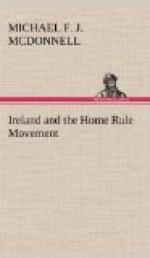The breaking up of the grazing lands, which in many instances the landlords are keeping back from the market, has not met with much success under the Act, and it is difficult to see how compulsion is to be avoided if the country is to be saved from the economically disastrous position of having established in it a number of occupying owners on tenancies which are not large enough to secure to them a living wage.
Under the Land Act of 1891 was created the Congested Districts Board, with an annual income of L55,000, for the purpose of promoting the permanent improvement of the backward districts of the West. The districts which come under its control are those which answer the following test, that more than twenty per cent. of the population of a county live in electoral divisions, of which the total rateable value gives a sum of less than 30s. per head of population. Such electoral divisions occur in the nine counties of Kerry, Cork, Galway, Mayo, Clare, Roscommon, Leitrim, Sligo, Donegal. In these counties there are 1,264 electoral divisions, of which 429 are congested. The setting up of particular districts as “congested” is, of course, quite arbitrary. There may be places outside the congested areas the condition of which is much worse than that of some of the congested districts, but if the population of these districts does not form one-fifth of that of the whole county they are ruled out of the scope of the Board’s activities.
The conditions which subsist in them have been ably described by M. Bechaux from personal observation, and he declares that the standard of living is lower than in any other country of Western Europe. Their inhabitants number more than half a million—that is to say, 10 per cent. of the total population of the island. Most of them have farms of two to four acres, and they pay from a few shillings to several pounds for rent. In many instances the rent which they pay is rather for a roof than for the soil. They eke out a precarious livelihood by migration to England, for there is but little demand for agricultural labour owing to the prevalence of pasture in the West. Fishing has served as a secondary source of income, and kelp burning was a profitable addition to their means until the discovery of iodine in Peru sent down the price to a marked extent.
The right of turbary, which nearly every tenancy possesses, is the one thing which has kept this population from starvation, and in the case of seaside tenancies a further gain accrues from the use made of seaweed as manure, which, owing to the absence of stall-feeding, is only to be obtained in this way. Home industries, such as weaving, form another source of profit, and last, but not least, must be reckoned the money sent home by relatives who have emigrated to America. Calves, pigs, and poultry are maintained in these circumstances, and, owing to the sale of the best of the stock, the breed has steadily deteriorated.




